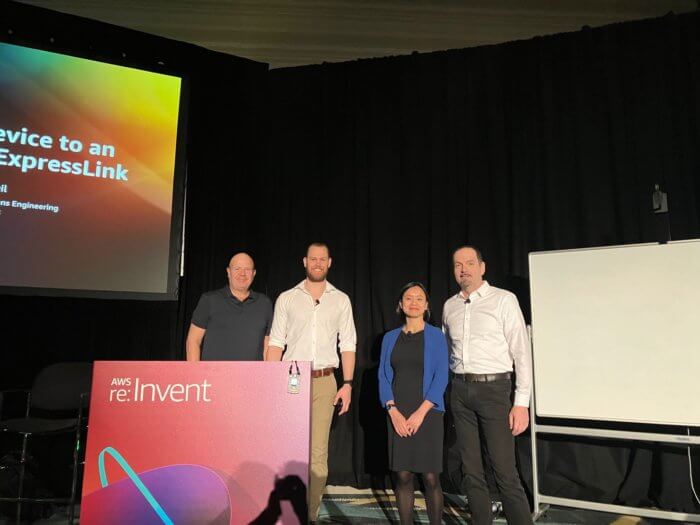The world is more connected than ever — and thanks to Amazon’s AWS IoT ExpressLink, connecting devices to our digital world is only getting easier.
As the world around us develops increased connectivity, organizations across industries are harnessing the power of the Internet of Things to improve productivity, enhance efficiencies and boost their businesses. Despite the myriad applications, advantages, innovations and improvements the IoT delivers, far too many companies still need help connecting products to the internet.
Contents
Streamline Your Connected Device Design with AWS IoT ExpressLink
To streamline that series of steps and minimize the design effort, Amazon Web Services launched AWS IoT ExpressLink, connectivity software that powers a range of hardware modules to provide cloud connectivity and implement AWS-mandated security requirements. We’re early adopters – in fact, one of our engineers is quoted about how easy AWS IoT ExpressLink makes the IoT product prototyping phase on the module’s landing page.
 At Cardinal Peak, we’ve worked with AWS technologies for over a decade, earning our IoT Core services delivery specialization as an ACE-eligible AWS IoT design partner. That knowledge and relationship allowed us to present our experience with — and the numerous advantages of — using ExpressLink at this year’s AWS re:Invent event in Las Vegas. re:Invent is an annual learning conference hosted by AWS that brings together about 50,000 members of the global cloud computing community.
At Cardinal Peak, we’ve worked with AWS technologies for over a decade, earning our IoT Core services delivery specialization as an ACE-eligible AWS IoT design partner. That knowledge and relationship allowed us to present our experience with — and the numerous advantages of — using ExpressLink at this year’s AWS re:Invent event in Las Vegas. re:Invent is an annual learning conference hosted by AWS that brings together about 50,000 members of the global cloud computing community.
This blog post dives into Cardinal Peak’s 2022 AWS re:Invent chalk talk, a presentation on how fast and easy it is to connect devices to securely the cloud with AWS IoT ExpressLink.
The Value of Connecting Your Device to the Cloud
Clients often approach Cardinal Peak for connected device development, wanting to connect their new or existing product to the internet for a variety of reasons. We help them determine the innovation’s exciting features and demonstrate the value of connecting the product to the cloud. The next step typically involves developing a proof of concept or building the entire connected product — and AWS IoT ExpressLink streamlines the development of devices that securely connect to the cloud.
IoT ExpressLink provides a simple, secure connection to the AWS cloud and the ability to easily integrate with over 200 AWS services. The product features a simple interface from the host processor to the cloud. It doesn’t require that developers set up Wi-Fi capabilities, MQTT, certificates or even debug to ensure that everything works — the ExpressLink module takes care of all those and more: firmware, provisioning of certificates and onboarding.
Check out this AWS ExpressLink blog post for more information including how it works, its development process, advantages and disadvantages, and different use cases.
Why Connect a Product to the Internet?
While there are many reasons a customer approaches us for help connecting a legacy device to the cloud, the most common causes include the following:
- Company leadership team believes it is important
- Competitors are doing it
- Belief IoT connectivity will improve the customer experience and increase product value
- Move to a recurring revenue, or software-as-a-service (SaaS), model
- Improve usage data collection and analysis for future enhancements
In many cases, clients are still trying to understand why they want to connect a product to the internet. Connecting products to the cloud offers the potential to fundamentally transform any business, but embedding connectivity also increases complexity. Regardless, we’ve been in the IoT game long enough to understand why connecting your product to the cloud creates greater value for users, the product experience or your business model. Even better, AWS IoT ExpressLink equips us to quickly develop compelling features that demonstrate a connected product’s value.
Compelling Connected Device Features
Connecting a product to the internet opens the door to a new world of possibility. With IoT connectivity, companies can discover usage patterns and visualize data at the individual and fleet levels to glean valuable insights. Today, organizations are deploying artificial intelligence and machine learning algorithms in the cloud to derive value from their devices. They are also connecting products to update the firmware when necessary and improve fleet management, providing simple and intuitive new features and bug fixes, configuration, diagnostics and customer support. Connected products also enable companies to enhance a user’s experience via notifications (achievements, badges and gamification), integrated mobile app user feedback or guidance on how to use the product correctly. The list goes on. Just know that there are so many other compelling device- and user-specific features that it would be impossible to highlight them all.
That said, it’s apparent why organizations might need to demonstrate the value their connected device delivers — but doing so can be complicated. Enter AWS IoT ExpressLink.
Transform Your Legacy Device to an IoT Device with AWS ExpressLink
Our re:Invent chalk talk, “Transform your legacy device to an IoT device with AWS IoT ExpressLink,” saw me and Sean O’Neil, Cardinal Peak’s VP of applications engineering, join Lucio Di Jasio and Lien Nguyen of AWS to chat all things AWS IoT ExpressLink. My demonstration portion focused on how ExpressLink accelerates time to proof of concept (POC).
Check out the full presentation on AWS re:Invent page.
Our AWS IoT ExpressLink re:Invent Presentation
Our client had an existing functional product but wanted data to go to the cloud. With IoT ExpressLink, it was easy to change the firmware on the device to write simple, plain-text commands and send data to the cloud. Plus, it was significantly faster than choosing a new chip, reimplementing firmware on the chip and adding communication to the cloud. We leveraged our recent experience with this customer to create a simple demonstration to include in our re:Invent presentation.
The demonstration — at a very high level — features two open windows:
- The browser in the AWS console
- A text terminal connected to ExpressLink
 For the demonstration, I was the host processor (instead of a microcontroller) and would type simple, plain-text commands over the serial port — just like a host processor would do. For example, I entered, “what is your name?” ExpressLink printed out “thingname.” In the console, we asked it to print its certificate, which showed it was the same device we were supposed to communicate with.
For the demonstration, I was the host processor (instead of a microcontroller) and would type simple, plain-text commands over the serial port — just like a host processor would do. For example, I entered, “what is your name?” ExpressLink printed out “thingname.” In the console, we asked it to print its certificate, which showed it was the same device we were supposed to communicate with.
Following another two or three commands, we were able to send a message. On the client side, the MQTT test client was listening for “hello, world.” I typed that command, and it showed up immediately — that easy.
By enabling companies to offload complex, undifferentiated work, implement AWS-mandated security practices and ensure trust with no sharing of information during manufacturing, IoT ExpressLink enables the quick transformation of any embedded device into an IoT-connected device with minimal design effort.
Clearly, there are numerous advantages of leveraging AWS IoT ExpressLink to connect your product to the internet. But numerous tradeoffs between utilizing ExpressLink or undergoing a complete redesign with a new system on a chip (SoC) make deciding which option is best quite tricky.
Cardinal Peak: AWS IoT ExpressLink Consultants
As an AWS IoT Core design partner, we’ve worked with AWS products for years and understand how to develop cost-effective and scalable solutions leveraging the AWS cloud to our customers’ collective benefit.
We’ve created multiple POCs to help our clients quickly gain insight and steer their decision-making as well as executed dozens of cloud production implementations. Having IoT ExpressLink as another option in our toolbox opens up development possibilities. We can either build connected products faster for an increased bill of materials or pay an engineer, add months to the build timeline and minimize the BOM but won’t experience some of ExpressLink’s additional advantages.
Moving forward, we’ll still be redesigning SOCs but know we can leverage IoT ExpressLink to accelerate POCs and speed time to market. If you’d like us to help transform your legacy device into an IoT device with AWS IoT ExpressLink, contact our IoT experts today!
